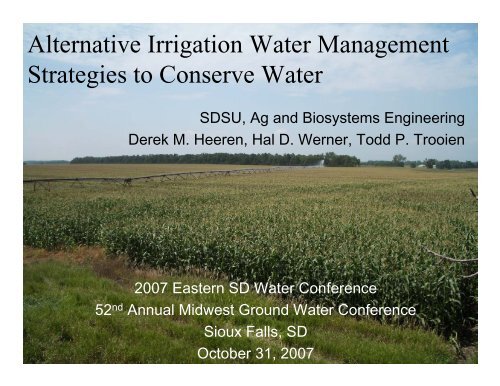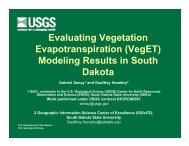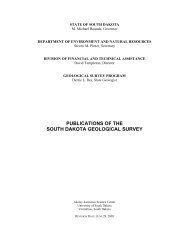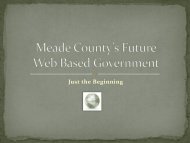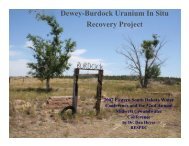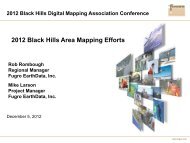Alternative Irrigation Water Management Strategies to Conserve Water
Alternative Irrigation Water Management Strategies to Conserve Water
Alternative Irrigation Water Management Strategies to Conserve Water
You also want an ePaper? Increase the reach of your titles
YUMPU automatically turns print PDFs into web optimized ePapers that Google loves.
<strong>Alternative</strong> <strong>Irrigation</strong> <strong>Water</strong> <strong>Management</strong><br />
<strong>Strategies</strong> <strong>to</strong> <strong>Conserve</strong> <strong>Water</strong><br />
SDSU, Ag and Biosystems Engineering<br />
Derek M. Heeren, Hal D. Werner, Todd P. Trooien<br />
2007 Eastern SD <strong>Water</strong> Conference<br />
52 nd Annual Midwest Ground <strong>Water</strong> Conference<br />
Sioux Falls, SD<br />
Oc<strong>to</strong>ber 31, 2007
<strong>Irrigation</strong> <strong>Water</strong> Use<br />
65% of fresh<br />
water use in the<br />
Western 22 states<br />
<strong>Irrigation</strong><br />
Other<br />
USGS, 2000
Already a limited supply…<br />
Drought<br />
Increasing demand on water for<br />
municipalities and environmental<br />
purposes<br />
Recent limits on water use for some<br />
irrigation districts in SD and NE
<strong>Irrigation</strong> <strong>Management</strong>:<br />
A Paradigm Shift?<br />
“…irrigated agriculture will be called upon<br />
<strong>to</strong> produce up <strong>to</strong> 2/3 of the increased food<br />
supply…”<br />
Increasing pressure on water resources<br />
New goal: “maximization of net benefits”<br />
Require greater understanding of<br />
irrigation-yield relationships<br />
English et al., 2002
Deficit <strong>Irrigation</strong> at Field Scale<br />
Deficit irrigation has been demonstrated<br />
at the field scale<br />
76% irrigation with 93% yield<br />
57% irrigation with 84% yield<br />
Klocke et al., 2004
A Faster Way?<br />
Using a crop model (instead of field<br />
testing)<br />
• Less time<br />
• Less money<br />
Objective:<br />
• Demonstrate an effective method for using<br />
DSSAT <strong>to</strong> develop irrigation strategies
Two Questions:<br />
How much water can be conserved<br />
without affecting yield?<br />
If a given amount of water is available,<br />
what strategy should be used <strong>to</strong> optimize<br />
yield?
Application<br />
<strong>Strategies</strong> can be incorporated in<strong>to</strong><br />
SDSU <strong>Management</strong> Software<br />
Producer selects best option based<br />
on water availability<br />
Real time moni<strong>to</strong>ring and<br />
adjustment
Scope<br />
<br />
<br />
16 <strong>to</strong> 24 years of weather data<br />
Sites across the Great Plains:<br />
• Oakes, ND<br />
• Brookings, SD<br />
• Akron, CO<br />
• Ord, NE<br />
• Rockport, MO<br />
• St. John, KS
Overview<br />
SDSU <strong>Management</strong> Software<br />
DSSAT Crop Model<br />
Challenges
SDSU <strong>Management</strong> Software<br />
Developed by Oswald (2006)<br />
Simulates a center pivot<br />
Field is divided in<strong>to</strong> 60 pie pieces<br />
• (soil water balance for each)<br />
Schedules irrigation based on ET<br />
calculation and soil water levels
SDSU <strong>Management</strong> Software<br />
Inputs include:<br />
• Crop type<br />
• Location<br />
• Weather data<br />
• <strong>Irrigation</strong> strategy<br />
Outputs include:<br />
• ET<br />
• <strong>Irrigation</strong> dates and amounts
<strong>Irrigation</strong> Strategy Defined<br />
<br />
e.g. MPAW = ( ( PAW2 – PAW1 ) / ( PM2 – PM1 ) ) * PM + PAW1
Spatial Variability in Soil <strong>Water</strong> Balance<br />
Brookings, SD, 1988, Corn, without ET Forecasting<br />
<strong>Water</strong> in Root Zone (cm)<br />
9<br />
8<br />
7<br />
6<br />
5<br />
4<br />
3<br />
2<br />
1<br />
0<br />
100 125 150 175 200 225 250<br />
Day of Year<br />
FC<br />
Maximum<br />
Mean + SDV<br />
Mean<br />
Mean - SDV<br />
Minimum<br />
MPAW
DSSAT Crop Model<br />
CERES-Maize model developed by<br />
Jones and Kiniry (1986)<br />
Daily calculation of:<br />
• ET and water uptake<br />
• <strong>Water</strong> and N stress<br />
• Corn development / dry matter<br />
accumulation
DSSAT Crop Model<br />
Inputs include:<br />
• Weather data<br />
• Soil data<br />
• Genetics (hybrid)<br />
• <strong>Management</strong> practices (e.g. irrigation)<br />
Outputs include:<br />
• Yield
Create Soil Profiles<br />
Brookings, SD, 1983-2006, Corn<br />
14000<br />
12000<br />
Mean Yield (kg/ha)<br />
10000<br />
8000<br />
6000<br />
4000<br />
2000<br />
0<br />
0 5 10 15 20<br />
Soil <strong>Water</strong> Holding Capacity (cm/m)
Compare Yield <strong>to</strong> County Averages<br />
Annual Irrigated Yield Comparison<br />
Brookings, SD<br />
Corn Yield (kg/ha)<br />
20000<br />
18000<br />
16000<br />
14000<br />
12000<br />
10000<br />
8000<br />
6000<br />
4000<br />
2000<br />
0<br />
1980 1985 1990 1995 2000 2005 2010<br />
Year<br />
DSSAT Optimum Yield<br />
County Average (irrigated)
Compare Yield <strong>to</strong> County Averages<br />
Corn Yield Without <strong>Irrigation</strong><br />
16000<br />
14000<br />
12000<br />
10000<br />
8000<br />
6000<br />
4000<br />
2000<br />
0<br />
DSSAT Best Variety<br />
Non-Irrigated County Avg.<br />
Oakes, ND<br />
Brookings, SD<br />
Akron, CO<br />
Ord, NE<br />
Rockport, MO<br />
St. John, KS<br />
Location<br />
Yield (kg/ha)
Test Yield Response <strong>to</strong> <strong>Irrigation</strong><br />
Yield v. <strong>Irrigation</strong><br />
16000<br />
14000<br />
Corn Yield (kg/ha)<br />
12000<br />
10000<br />
8000<br />
6000<br />
4000<br />
2000<br />
0<br />
0 10 20 30 40 50<br />
Seasonal <strong>Irrigation</strong> (cm)
Challenges<br />
DSSAT:<br />
• Lower ET<br />
<br />
(even though both used FAO-56)<br />
• Higher soil water balance<br />
• Less water stress on crops
ET Challenges<br />
<br />
Expected<br />
reference ET <strong>to</strong><br />
decrease with<br />
increasing dew<br />
point<br />
EO (mm)<br />
5.15<br />
5.14<br />
5.13<br />
5.12<br />
5.11<br />
5.1<br />
5.09<br />
5.08<br />
5.07<br />
5.06<br />
5.05<br />
DSSAT EO v. Tdew<br />
0 5 10 15 20 25 30<br />
Tdew (C)<br />
<br />
ET did not respond when RH values were<br />
changed <strong>to</strong> 0% and 100%
Crop ET: DSSAT Compared <strong>to</strong> SDSU<br />
<strong>Management</strong> Software<br />
Crop ET % Error<br />
Dry Year<br />
Normal Year<br />
Wet Year<br />
Akron, CO<br />
27.1*<br />
3.4*<br />
34.2<br />
Brookings, SD<br />
56.3<br />
10.8<br />
1.9<br />
Rockport, MO 47.6<br />
23.3<br />
*short season due <strong>to</strong> early crop failure in DSSAT<br />
22.7<br />
Reference ET error: 5 – 13%<br />
Some error in crop ET is due <strong>to</strong> crop coefficients (SDSU<br />
<strong>Management</strong> Software) and partitioning (DSSAT)
Comparison: Soil <strong>Water</strong> Levels<br />
Soil <strong>Water</strong> Balance, Brookings, SD, 1988<br />
63 L/s Pump (1000 GPM)<br />
Plant Available <strong>Water</strong> (%)<br />
100<br />
75<br />
50<br />
25<br />
0<br />
100 125 150 175 200 225 250<br />
Day of Year<br />
DSSAT<br />
SDSU<br />
<strong>Management</strong><br />
Software<br />
Minimum
Conclusion<br />
<br />
<br />
Challenges were encountered with the ET<br />
component in DSSAT.<br />
If differences in the water balance between<br />
DSSAT and SDSU <strong>Management</strong> Software can<br />
be reconciled, this may be a cost effective<br />
way <strong>to</strong> develop irrigation strategies for limited<br />
water scenarios.
Acknowledgement<br />
<br />
SD <strong>Water</strong> Resources Institute<br />
Reference<br />
<br />
Heeren, D.M., H.D. Werner, T.P. Trooien. 2007. Evaluation<br />
of irrigation strategies with the DSSAT cropping system<br />
model. ASABE Section Meeting Paper No. RRV-07132. St.<br />
Joseph, Mich.: ASABE.
Questions


